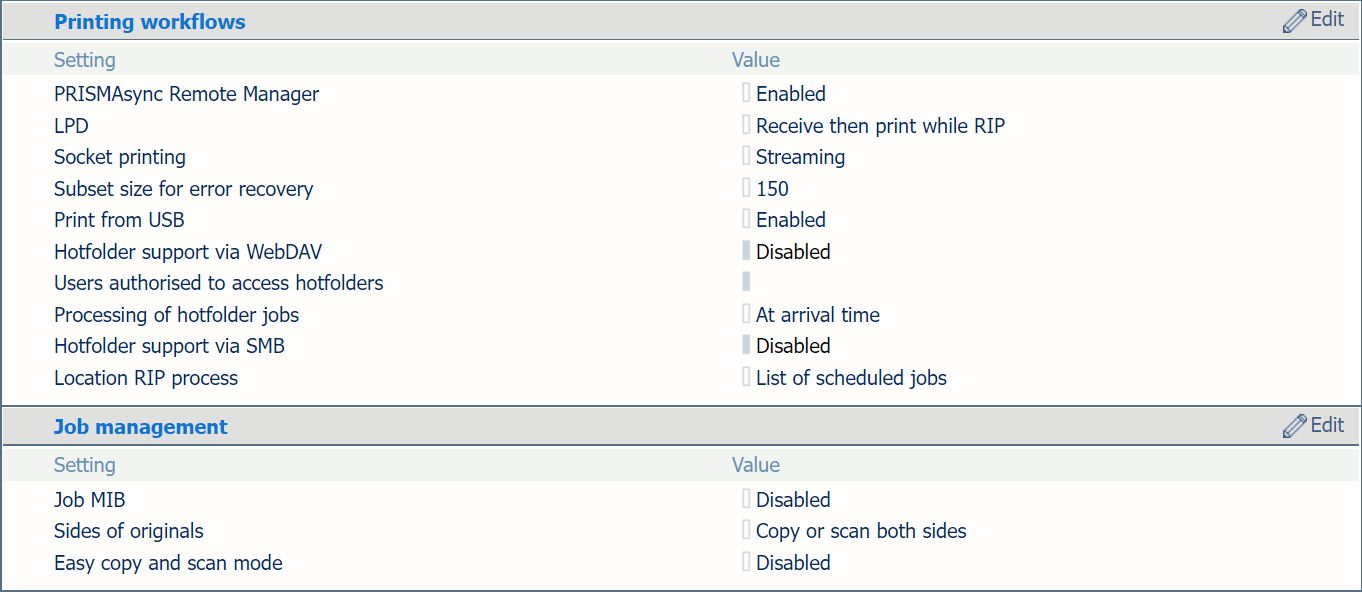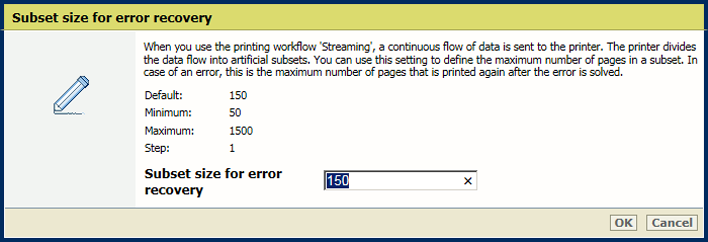

You can define how jobs are processed by default.
Open the Settings Editor and go to: .
 [Systeeminstellingen] tab
[Systeeminstellingen] tabGo to the [Workflows voor afdrukken] and [Opdrachtbeheer] sections.
 [Workflows voor afdrukken] and [Opdrachtbeheer] sections
[Workflows voor afdrukken] and [Opdrachtbeheer] sectionsThe printer protocol LPD can be enabled by the system administrator. The print protocol LPR must be installed on the workstation that submits the jobs.
Use the [LPD] setting to indicate when the RIP starts to process LPR jobs.
[Streaming] is applicable to large jobs. The job is processed by the RIP and printing can start at the same time.
[Ontvangen, vervolgens afdrukken tijdens rippen] is the default value and is applicable to smaller jobs that have multiple sets. The RIP starts to process the jobs after they arrive in the print queue and before the whole job has been received.
 [LPD] setting
[LPD] settingSocket printing can be enabled and configured by the system administrator.
Use the [Afdrukken via de socket] setting to indicate when the RIP starts to process jobs that use the socket printing port.
[Streaming]: is default value and applicable to large jobs. The job is processed by the RIP and printing can start at the same time.
[Ontvangen, vervolgens afdrukken tijdens rippen]: is applicable to for smaller jobs that have multiple sets. The RIP starts to process the jobs after they arrive in the print queue and before the whole job has been received.
 [Afdrukken via de socket] setting
[Afdrukken via de socket] settingUse the [Formaat subset voor foutherstel] setting to define the number of pages that will be printed again after the error is solved.
 [Formaat subset voor foutherstel] setting
[Formaat subset voor foutherstel] settingThe system administrator can change the processing order of hotfolder jobs.
Use the [Verwerking van hotfolderopdrachten] setting to indicate how jobs are processed in the hotfolder.
[Op basis van tijd van aankomst]: job processing takes place when the job arrives in the hotfolder.
[Volgorde op basis van opdrachtnaam]: job processing takes place according to the alphabetical order of the job names.
 [Verwerking van hotfolderopdrachten] setting
[Verwerking van hotfolderopdrachten] settingUse the [Afdrukken vanaf USB] setting to indicate whether printing from a USB drive is allowed.
 [Afdrukken vanaf USB] setting
[Afdrukken vanaf USB] settingUse the [Locatie RIP-proces] setting to indicate where the RIP processes jobs when they arrive in the print queue.
[Alle locaties]: the RIP can process jobs in all job destinations.
[Lijst met geplande opdrachten]: the RIP can only process jobs when they are in the list of scheduled jobs.
 [Locatie RIP-proces] setting
[Locatie RIP-proces] settingUse the [MIB van opdracht] setting to indicate if remote monitoring of jobs via SNMP is allowed.
 [MIB van opdracht] setting
[MIB van opdracht] settingUse the [Zijden van originelen] setting to indicate if originals have information on one or both sides.
 [Zijden van originelen] setting
[Zijden van originelen] settingUse the [Modus voor eenvoudig kopiëren en scannen] setting to indicate that you want to enable the easy copy and scan mode.
[Ingeschakeld]: the last used job template will be re-opened when the operator starts a new copy or scan job.
[Uitgeschakeld]: the last used job template will close when the operator starts a new copy or scan job.
 [Modus voor eenvoudig kopiëren en scannen] setting
[Modus voor eenvoudig kopiëren en scannen] setting